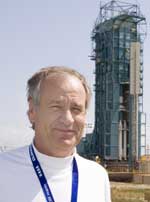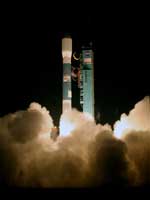The Research Angle: CloudSat's Unique Data Excites Scientists Around the World
 |
|
Graeme Stephens poses in front of the Boeing Delta II rocket prior to the launch of CloudSat/CALIPSO from Vanderberg Air Force Base.
|
Scientists worldwide are clamoring for the first-of-its-kind information about clouds from CloudSat, the world's first cloud-profiling radar in orbit, said Graeme Stephens, CSU atmospheric science professor.
CloudSat blasted into space above Vandenberg Air Force Base north of Santa Barbara, Calif., on April 28 with CALIPSO, another NASA Earth Observation Satellite, aboard a Boeing Delta II rocket.
"The international attention has been intense and is only going to grow," said Stephens, CloudSat's inventor. "The data are already flowing to the European operational forecast center in the U.K., to research groups in Europe, Canada and Australia. The University of Tokyo is sending a post-doctoral researcher to learn about CloudSat data - and we in turn about the their models that run on the massive Earth simulator computer - and China is becoming immensely interested in CloudSat and the possibility of launching their own version."
CloudSat is the first space-borne millimeter-wavelength radar to look vertically at the characteristics of clouds and precipitation, particularly water and ice content that could help scientists improve predictions of climate changes and weather patterns. In addition to improving weather forecasting, the data will help investigate how clouds determine Earth's energy balance, increase the accuracy of severe storm warnings, improve water resource management and develop even more advanced radar technology.
The Cooperative Institute for Research in the Atmosphere or CIRA, which is based at Colorado State, collects CloudSat data and distributes it to scientists around the globe.
 |
CloudSat's first images, released in early June, captured as much media attention as the launch itself because the world witnessed unprecedented views of clouds and storms such as Tropical Storm Alberto. In July, CloudSat recorded images of the increasing intensity of Hurricane Daniel in the central Pacific Ocean east of Hawaii.
Stephens, a University Distinguished Professor in the college's Department of Atmospheric Science, has spent more than a decade of his career on CloudSat. Cooperating on the project were NASA's Jet Propulsion Laboratory, Ball Aerospace and Technologies Corp., the Canadian Space Agency, the U.S. Department of Defense and the U.S. Air Force.